
The 2023 Field Methods in Paleobiology course revisited the Basin & Range Province in Nevada and Utah, lead by Professors Seth Finnegan and Jack Tseng. Seth and Professor Cindy Looy spearheaded this trip back in 2017, which was documented by my predecessor Dave Smith. Find them here: part 1 and part 2.
The group would investigate Paleozoic-early Mesozoic shale and limestone topped by Miocene-Pleistocene deposits of sedimentary rock and perhaps learn about how that unconformity came to be. These field trips provide students with the opportunity to make connections between the fossils and landscape, and learn about paleontology and geology in person.
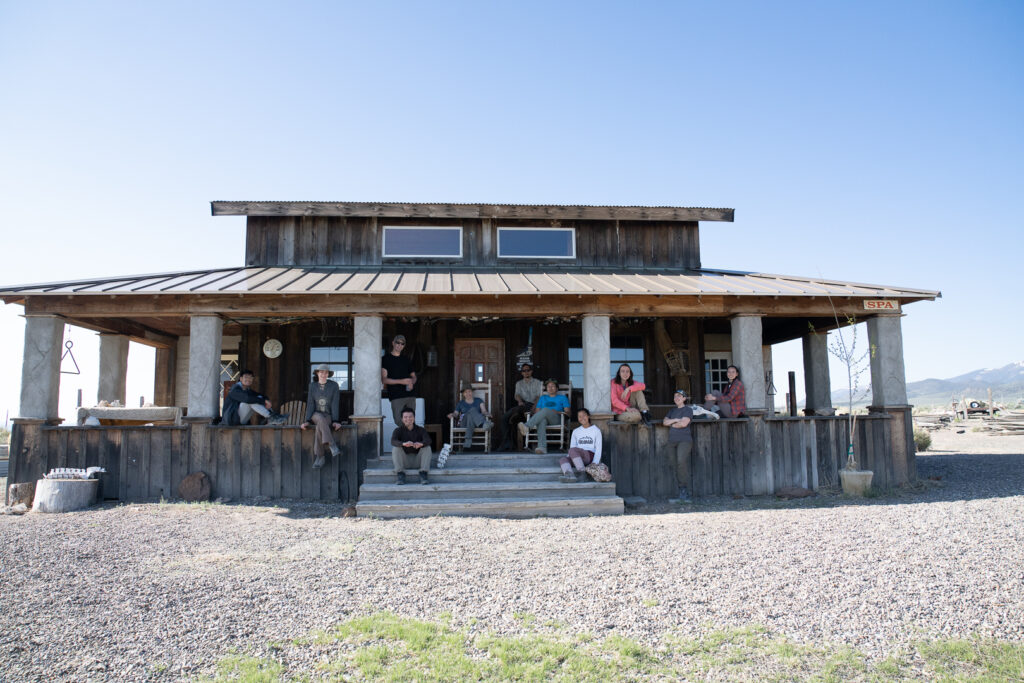
Tuesday May 16
The class left Berkeley for Fernley, NV at 6am and met up with Mike Bell to explore the Miocene diatomite lake beds and look for amazingly preserved stickleback and killifish fossils. We previously saw these lake beds being studied by graduate student Tanner Frank (https://ucmp.berkeley.edu/2020/05/stickleback-desert-oasis/). The group would see more of the Miocene further east in Buffalo Canyon. Cindy and Ivo very smartly prepped their famous Veggie Chili by making it at home and freezing it. By dinnertime, the chili had thawed and was ready for heating up.
Pictured above: The group sifting through flakey layers of diatomite in search of killifish and sticklebacks. Photo credit Jack Tseng. Stickleback in diatomite. Photo credit Maya Samuels-Fair. Riley Hayes sifting through Buffalo Canyon shale for leaves. PC Maya Samuels-Fair, Fossilized leaf margins. PC Kayli Stowe. Ben Muddiman, Jaemin Lee, Ivo Duijnstee and Riley Hayes in Buffalo Canyon. PC Cindy Looy.
Wednesday May 17
In the morning, the group broke camp and explored more of the Buffalo Canyon area where members of the Looy Lab had been collecting there the day before. Soon, they departed Buffalo Canyon and while Ben, Jaemin and Ivo headed back to Berkeley, everyone else headed to Berlin Ichthyosaur State Park, which was also founded in part by UCMP’s financier Annie Alexander, and spearheaded by UCMP’s third director Charles Camp and Margaret Wheat, as noted in Dave Smith’s piece on the history of the park. The large vertebrate marine fossils were fascinating and a welcome pit stop for the vertebrate paleontologists before heading into the land of small marine invertebrates. Leaving Berlin Ichthyosaur State Park, the group encountered the first flat tire of the trip, but they arrived safely at Hot Springs Ranch.
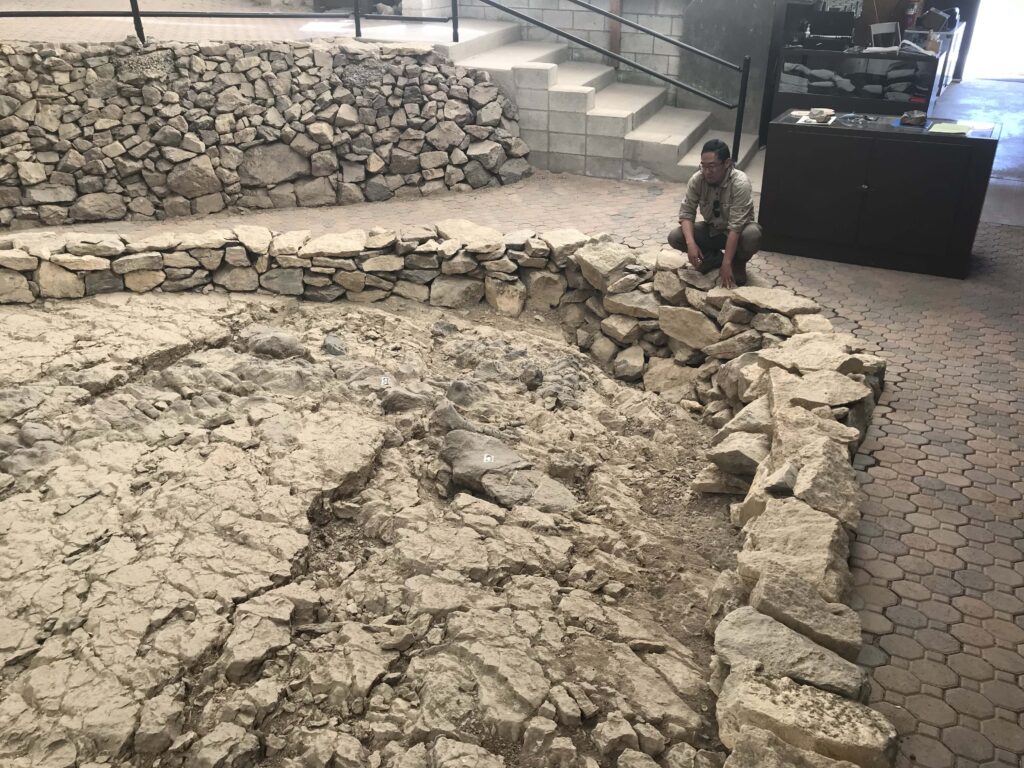
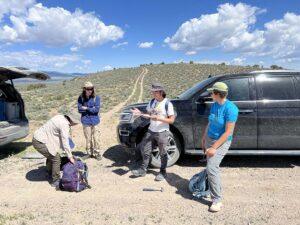
Thursday May 18
The group explored Red Hill where Derrick is conducting research on Devonian fish and origins of lateral lines. Afterwards, the group went off to explore the Pleistocene around the base of Lone Mountain. Part of this adventure was creek crossing! Sometimes field work is fun.
The same morning, Leah and I began our own adventure on our way to rendezvous with the group at Hot Springs Ranch. We left later to accommodate Leah’s graduation where she received the Natural History Award and Departmental Citation in Integrative Biology, and the Departmental Citation in Earth and Planetary Sciences. After lunch at Great Basin Brewery, whose mascot is an ichthyosaur, we headed out to cover another 230 miles and needed to stop for gas in Middle Gate – one of the few gas stations along the Loneliest Highway. This place had everything, a bar, ice cream and gasoline that came out of a literal tank. There was also electric vehicle charging station. It was an experience.
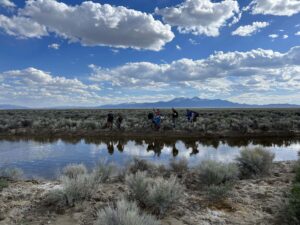
We arrived at Hot Springs Ranch around 5pm. This small plot was something like a field station for us traveling paleontologists complete with an industrial kitchen, bunk beds, a tee pee, and of course, hot springs. We shared the area with the local desert wildlife: coyotes, kangaroo rats and rattle snakes! One of which Jack found in the tee pee when setting up for the night. Reunited, we enjoyed a dinner of leafy greens and bean insalata prepped by Tara and Derrick. It was then, I revealed my gift of SPAM musubi.
Friday May 19
In the AM we left for Utah, with the two Chevy Suburbans, a Ford Expedition and a Subaru Forester. We stopped in Ely to gas up and replenish food supplies, followed by another stop at the Border Inn (At the border of Nevada and Utah) to gas up again since there would be no more infrastructure as we headed into the Great Basin.
At a gravel road off the main highway, we got a good overview of the House and Confusion ranges. From this view, we could see our campsite, situated at the top of the House Range, and a view of the Notch (above). During lunch, Seth handed out books about the area. I picked out one titled Hiking, Climbing & Exploring Western Utah’s Jack Watson’s Ibex Country.
This book contains interesting stories about the history of the general area and included the story Bob Stinson, an infamous hermit who lived in the Hermit Hut landmark of Marjum canyon, where we learned that he raised live badgers. This book also touched upon the history of U.S. citizens of Japanese descent imprisoned in the Topaz internment camps, who’s labor was used to mine for trilobites.
Pictured above: A small conglomeration of bivalves, a pronghorn, the view from Swasey Springs. PC Helina Chin, Leah Kahn and Maya Samuels-Fair
Afterwards, we headed to the Triassic. We made our onto a gravel and dirt road that would soon take us onto a narrow and bumpy two track filled with sharp limestone rocks and ever present fear of flat tires. Thankfully we made it to Disappointment Hills and even spotted a pronghorn along the way! At the exposure, we encountered bivalves, gastropods, and algae.
Afterwards, we carefully drove out, crossed the high way and started a convoluted climb up to the campsite at Swasey Springs. The canyon environment was dry and desert like but after we traversed the spine of the ridge, the vegetation changed from small, low shrubs and bushes to larger junipers and pine trees. In an hour we reached the top of the range. Jack and Sergio prepared a dinner of tofu fajitas. The tofu was lightly marinated in cerveza. If you haven’t tried it, try it!
It was here that Bob Gaines of Pomona College joined us. Bob is friend and former lab mate of Seth’s during their time at UC Riverside. He would be our guide into the Cambrian later on.
Saturday May 20
In the morning we broke camp and set back down the range. On the way to learn about the Cambrian, we stopped at a sandy-looking bed of an ancient lake at Dome Canyon, also known as Death Canyon. Here, we found Pleistocene age molluscs that had been bleached white.
However, further back in time in the Cambrian, this area looked very different. Bob explained that the edge of continents were sinking and oceans moved over the surface of the inner portion of current day Nevada and Utah before being entirely submerged leading up to the early Cambrian. This movement created a shoreline characterized by these ocean sediment deposits.
Pictured above: Collared lizard, ichnofossils characterized by white markings in limestone, Pleistocene molluscs, Riley Hayes presenting in the Wheeler Shale, Seth Finnegan and students talking about the ichnofossils, oncoids, Kayli Stowe in the trilobite quarry and stromatolites near Fossil Mountain. PC Helina Chin.
We headed to the Marjum Canyon area in the House Range to investigate ichnofossils, also known as trace fossil. What looks like diluted white paint on the gray rocks is actually evidence of animal behavior during that time. We also encountered modern animals in the form of a collared lizard. Here, Bob challenged the group to try to think ecologically, and imagine water in this dry area. We also noted the oncolitic limestone with small layered spheres, called oncoids, of alternating rock and cyanobacteria (ocean photosynthesizers).
Further east at our next stop, Riley gave a quick presentation about the Wheeler Shale followed by a short hike to find trilobites and observe the high quality preservation similar to Canada’s Burgess shale site. Here we found agnostids, small arthropods similar to trilobites. Whether they belong within the trilobite family is still up for debate. However, if you’re looking for them and have seen mitosis under a microscope, then you’ve got a good search image for this fossilized creature. Next, we explored a commercial trilobite quarry. Here we found high quality preservation of whole and disarticulated trilobites, mostly Asaphiscus wheeleri and Elrathia kingii. Helina found a trilobite that also showed evidence of shearing forces applied to the shale. Varied in their shape and form, trilobites were prolific in their time, with over 25,000 known species worldwide.
Next, we stopped at Bob’s current site of research, a small exposed mound of Cambrian aged shale where we found everything from trilobites, other unidentified arthropods, whole sponges, of which we had only been finding fossilized spicules. Finally another short hike up to see the stromatolites and thrombolites. Much like a croissant, one can observe the lamination of layers of fossilized microbial mats and sediments. Afterwards we drove through the playa of the Ibex region to our campsite at the base of Fossil Mountain. Helina and Derrick harnessed the power of wok hei to prepare dinner of Tofu Lo Mein (and later with Spam for Jack). with help from Kayli, James and Cindy.
Sunday May 21
The morning began ominously, as one Suburban had gotten a flat tire overnight. We were able to pile everyone into the remaining Suburban and Explorer and went out to a beautiful exposure of House Range limestone of the Hintze section B. We parted ways with Bob and headed out on our own to the Hintze section H. However, on a rocky two-track, the rear driver side tire of the Suburban had gotten a puncture. Seth and Jack needed to slowly drive down to a flat area to replace the tire with the last spare.
Pictured above: Kayli Stowe climbing up limestone in section B. Seth Finnegan and Bob Gaines modeling the same green felt hat. Calathid fossils. The group getting ready to climb up section J.
After lunch we hiked Hintze section J, a steep exposure. Much of Seth’s PhD work was done here. Dave provided more detail about Hintze in his 2017 blog, “More than 60 years ago, geologist Lehi Hintze, who studied these Lower Ordovician rocks extensively, first measured this section and painted his measurements directly on the rocks. The measurements would have been erased by the elements long ago, but geologists periodically repaint them.”
Back at camp, a small group went up to visit the Kanosh. Kayli and Leah made pasta and salad for dinner of the final night of the trip.
Monday May 22
On top of learning about the interesting paleoecology of the Basin & Range, students also learned how not everything can go as planned and gaining that experience in the field, and even learning how to change a flat tire helps them deal with problems in their own field research programs.
As we prepared to head back to Berkeley, the spare tire wasn’t holding air as tightly, with the low-tire warning popping up a few times, and while we had an air compressor, we decided to see if any mechanics or tire centers help us with our tires and pushed our departure, and arrival home, back an hour. Unfortunately, no one could help us. So we trudged on and hoped for the best.
The issues on the road took a dramatic turn when one of the wheel bolts snapped off the rear driver side wheel of the Suburban. We tightened up the best we could and revisited tire shop in Ely to see if they had the parts to make it back but alas, they did not. After making calls to the rental car company, our best bet was to hobble over to Reno at 50mph, where we would switch out two 6-seater SUVs to one 12 seater van at the Reno Airport. Unfortunately, a single car crash blocked both sides of highway 50 on the way into Reno. The driver was okay but we were delayed for about 2 hours. Our trip home went from a 9 hour drive into a 16 hour drive and we got back to Berkeley campus at 11pm.
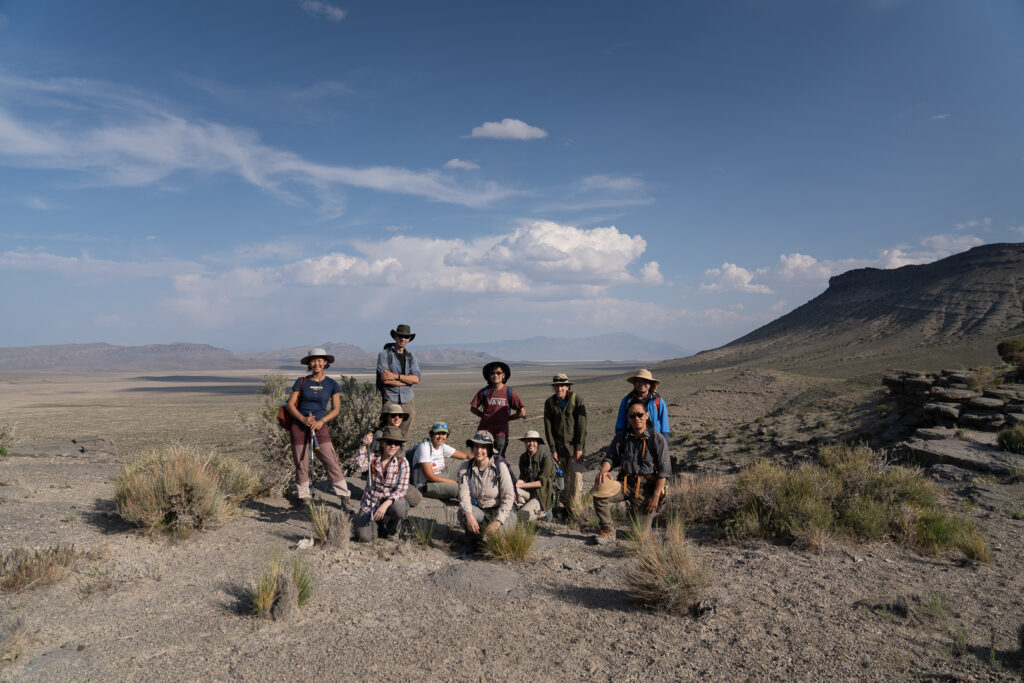
Can’t wait to do this again next year!